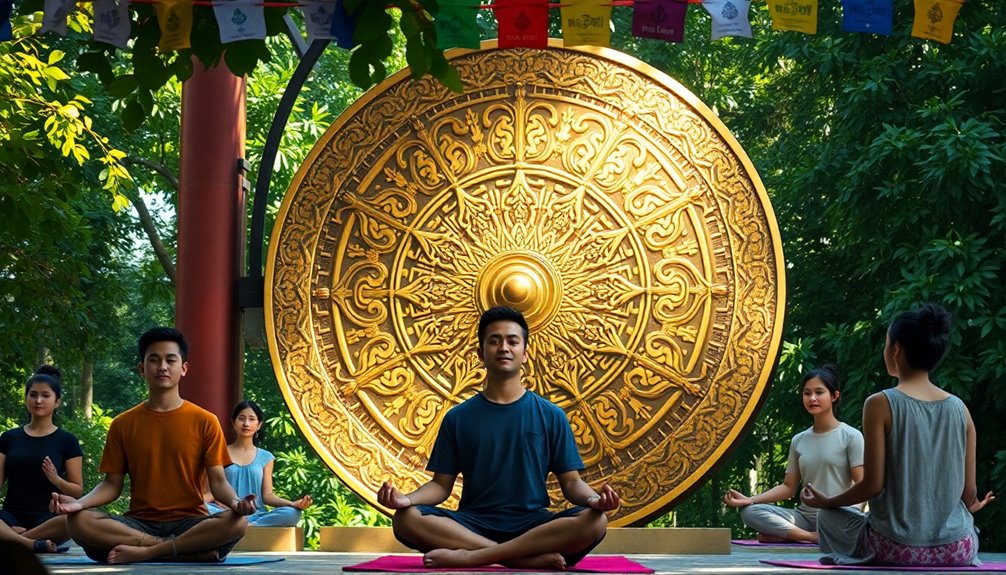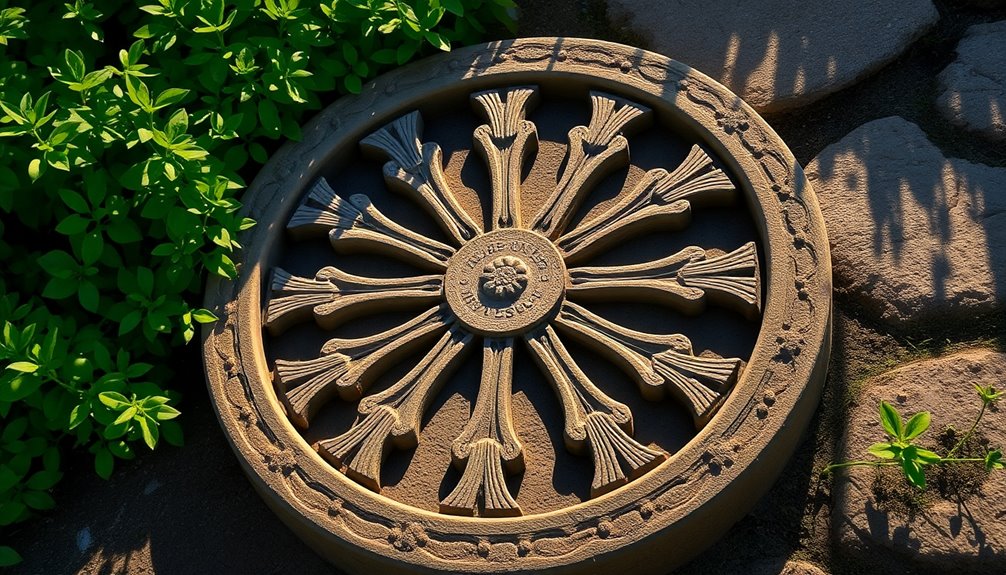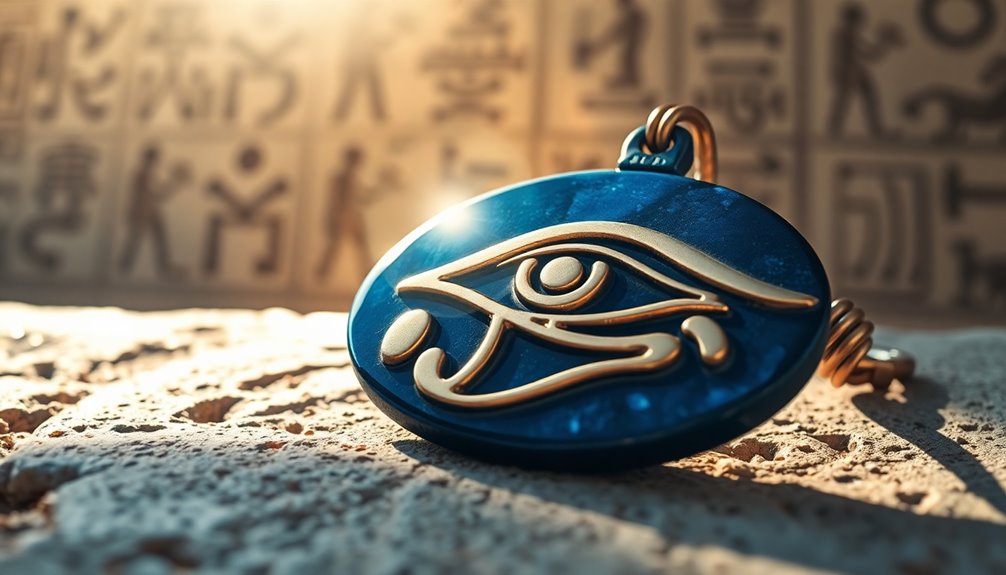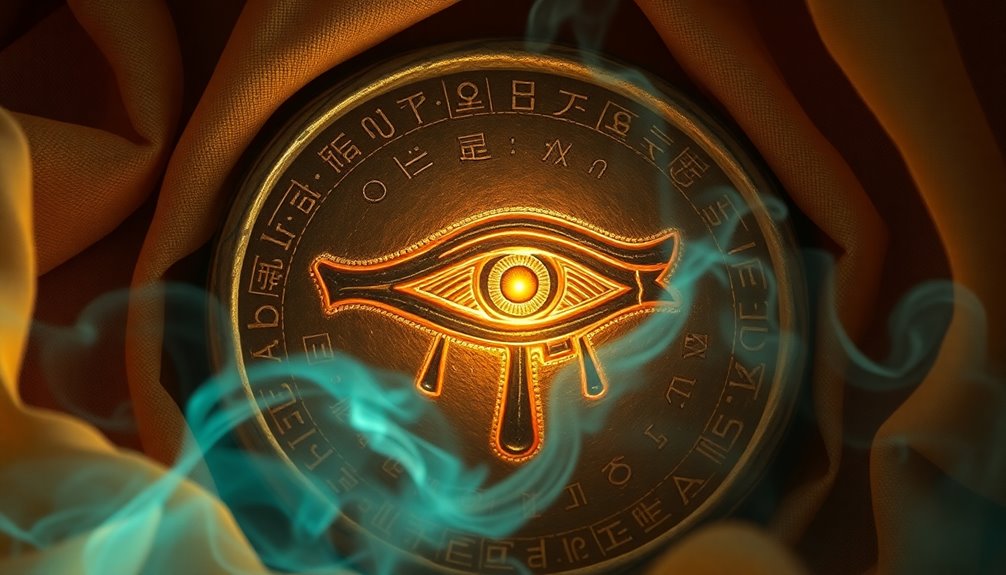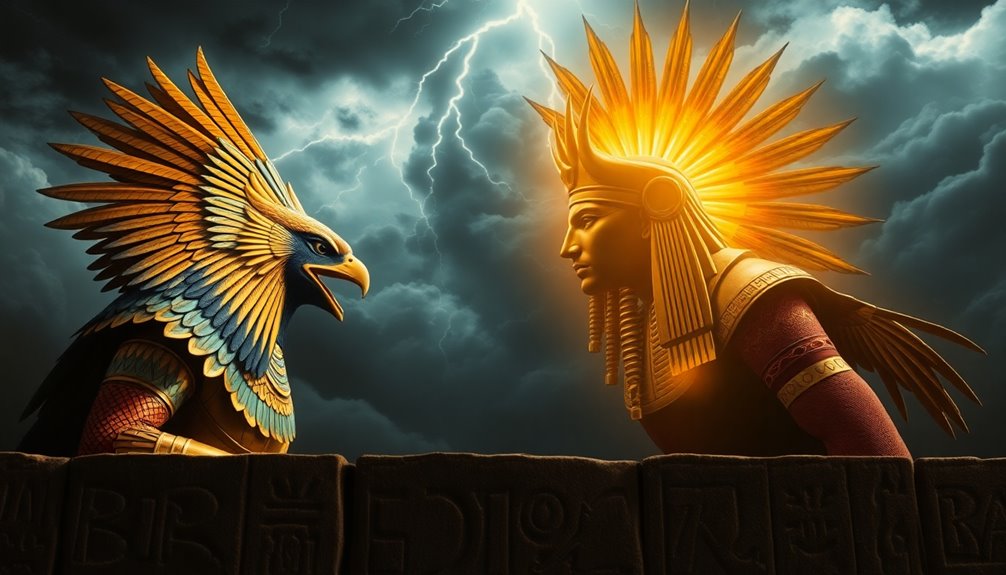The Dharma Wheel, a essential symbol in Buddhism, is making waves in modern culture. You'll find it in art, fashion, and public symbols, shaping messages around justice and mindfulness. It represents the Noble Eightfold Path, guiding personal growth and ethical living. Countries like India display the wheel in their emblems, symbolizing moral order and social justice. Even contemporary artists reinterpret it to tackle today's social issues. This surprising relevance reminds us that ancient symbols can still inspire meaningful change. Ready to explore how this emblem continues to evolve and inspire?
Key Takeaways
- The Dharma Wheel symbolizes justice and moral order in modern governance, notably featured in India's State Emblem with 24 spokes.
- Contemporary artists reinterpret the Dharma Wheel in urban art, addressing themes of resilience, mindfulness, and spiritual journeys.
- The Dharmachakra is used by the Dalit Buddhist Movement to advocate for social equality and justice within society.
- U.S. Armed Forces' Buddhist chaplains adopt the Dharma Wheel symbol, reflecting its diverse significance in military contexts.
- The Dhammacakka flag in Thailand reinforces Buddhism's cultural importance during religious ceremonies, showcasing the wheel's enduring relevance.
Etymology and Historical Context
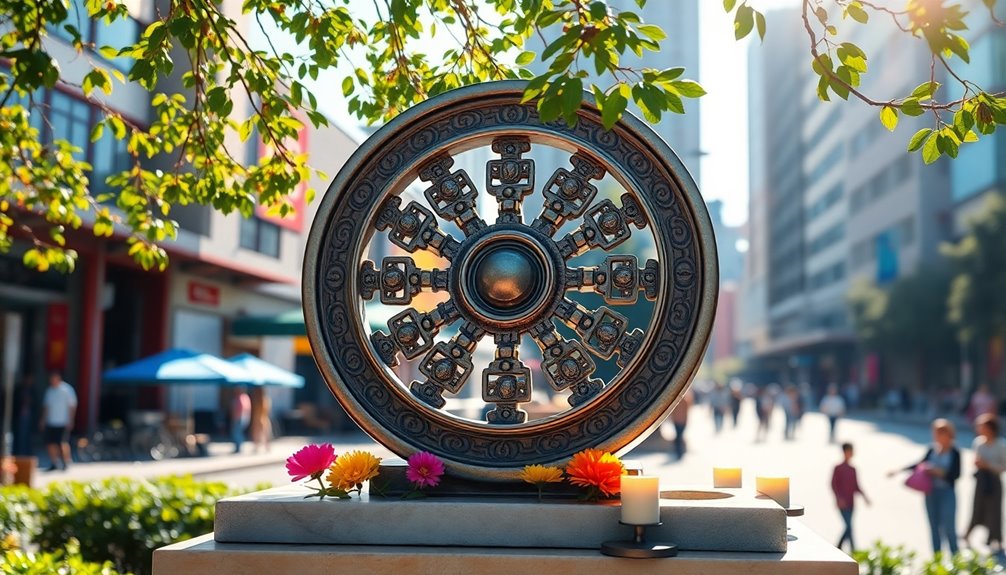
Rooted in ancient traditions, the term dharma comes from the Sanskrit noun (धर्म), which signifies law or duty. This concept is steeped in history and deeply connected to the verb dhṛ, meaning to hold or maintain. Historically, dharma relates to the Vedic idea of Ṛta, representing the cosmic order that governs the universe.
When you explore this term, you uncover its role in shaping moral law within society.
The wheel symbol, often associated with Buddhism, has ancient roots, evident in artifacts from the Indus Valley civilization. These circular motifs, including wheels, indicate their longstanding significance in Indian culture.
One notable archaeological find is the Dholavira Signboard, which features a sequence of ten signs, including wheel symbols, demonstrating the use of wheels in ancient Indian iconography.
Moreover, in Vedic texts, the surya (sun) is depicted as a solar disc, described as a chariot of one wheel (cakra). This imagery symbolizes divine power and the cosmic cycles that resonate through early Hinduism, illustrating how interconnected these symbols are with the concept of dharma throughout history. Understanding the historical context of symbols like the wheel can enhance our appreciation of their influence on modern practices, especially in how they reflect the importance of regulatory compliance within various cultural frameworks.
Symbolism in Buddhism
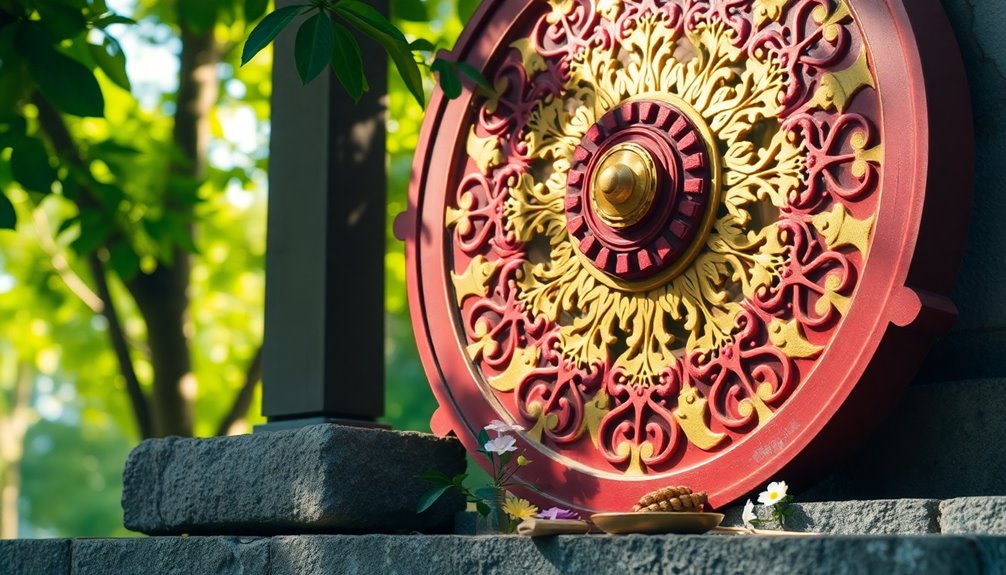
When you explore the symbolism in Buddhism, you'll find that the Dharma Wheel has deep historical roots and modern interpretations.
Its design reflects essential teachings and principles that guide practitioners on their spiritual journey.
Understanding these layers can enrich your appreciation of this iconic symbol and its relevance today.
Historical Context and Origins
The Dharma Wheel, known as the Dharmachakra, embodies the essence of Buddhist teachings and reflects a rich historical context that traces back to ancient Indian spirituality. This symbol, derived from the Sanskrit word dharma, represents the moral order of the universe and the teachings of Buddha.
Its roots can be found in Vedic texts, where it connects to the solar disc and the god Surya, emphasizing its significance in early Indian culture.
The first major use of the Dharma Wheel as a Buddhist symbol emerged during the reign of King Asoka around 250 BCE. This period marked a pivotal moment in the spread of Buddhist teachings across India and beyond.
Here are three key aspects of its historical context:
- The wheel typically features eight spokes, symbolizing the Noble Eightfold Path.
- It highlights the steps necessary for achieving enlightenment and escaping samsara.
- The Dharma Wheel is considered one of the ashtamangala, or auspicious signs, illustrating the cyclical nature of life and the doctrine of dependent origination.
Understanding its origins helps you appreciate the depth of the Dharma Wheel in Buddhism today.
Modern Symbolic Interpretations
Symbolizing the core teachings of Buddhism, the Dharma Wheel transcends its historical origins to find relevance in modern interpretations. The Dharma Chakra, often recognized as the symbol of Buddhism, has adapted to contemporary contexts. For instance, it features prominently in the State Emblem of India, reflecting the nation's commitment to justice and moral order, which resonates with the teachings of the Buddha. The Dharma Wheel serves as a reminder of the importance of honoring one's legacy, encouraging individuals to reflect on their values and actions. Additionally, the symbolism of the Dharma Wheel can be seen as a representation of economic impact, highlighting how cultural symbols can contribute to community development and cohesion.
In Thailand, the Dhammacakka flag represents Buddhism during religious ceremonies, reinforcing the cultural significance of the Dharma Wheel. Furthermore, the U.S. Armed Forces Buddhist chaplains incorporate the Dharmachakra in their insignia, highlighting its role in supporting spiritual well-being among service members.
The flag of the Indian Dalit Buddhist Movement prominently showcases the Dharma Chakra, symbolizing the fight for social justice and equality, further emphasizing its relevance. Additionally, the 16-spoke Dharmachakra appears on the flag of the Romani people, honoring its Indian origins while showcasing its enduring significance across diverse communities.
Through these modern symbolic interpretations, the Dharma Wheel continues to inspire and unite individuals in their pursuit of justice and moral integrity. Additionally, the use of the Dharma Wheel parallels the emphasis on traditional healing practices within Aboriginal cultures, highlighting the universal quest for well-being across diverse spiritual traditions.
The Noble Eightfold Path
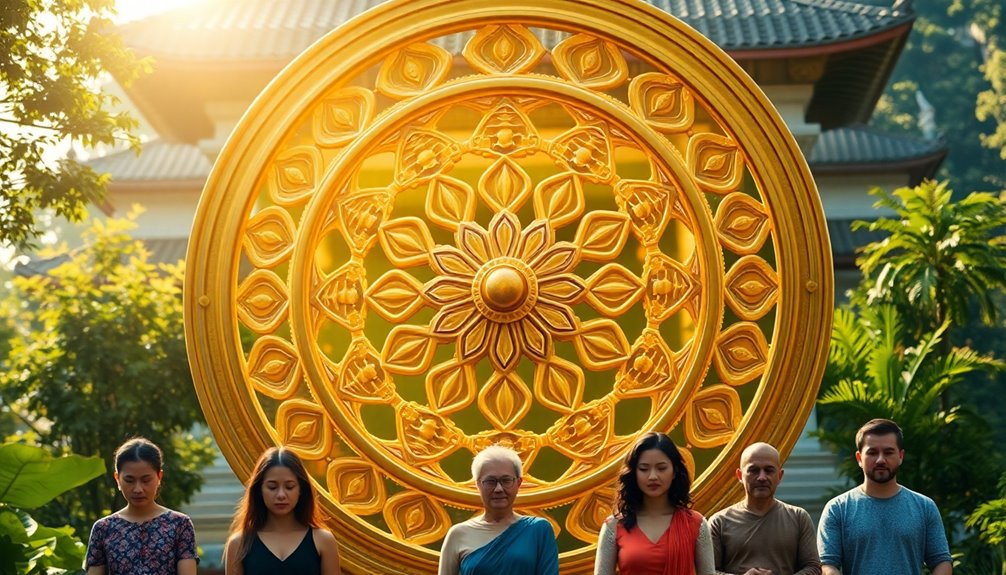
Eight essential practices make up the Noble Eightfold Path, a fundamental teaching in Buddhism that guides you toward ethical living and mental development. This path consists of interconnected practices that promote a holistic approach to personal growth, ultimately leading you to enlightenment.
Each element plays a crucial role in shaping your life and spiritual journey:
- Right View: Understanding the nature of reality and suffering.
- Right Intention: Cultivating positive thoughts and motivations.
- Right Speech: Communicating truthfully and harmoniously.
The Noble Eightfold Path is often represented as the eight spokes of the Dharma Wheel, symbolizing the interconnectedness of all Buddhist teachings.
These spokes work together, emphasizing that personal development isn't linear; you can engage with them in various orders and combinations. This flexibility allows you to adapt your spiritual practice to your unique experiences and challenges.
Artistic Representations
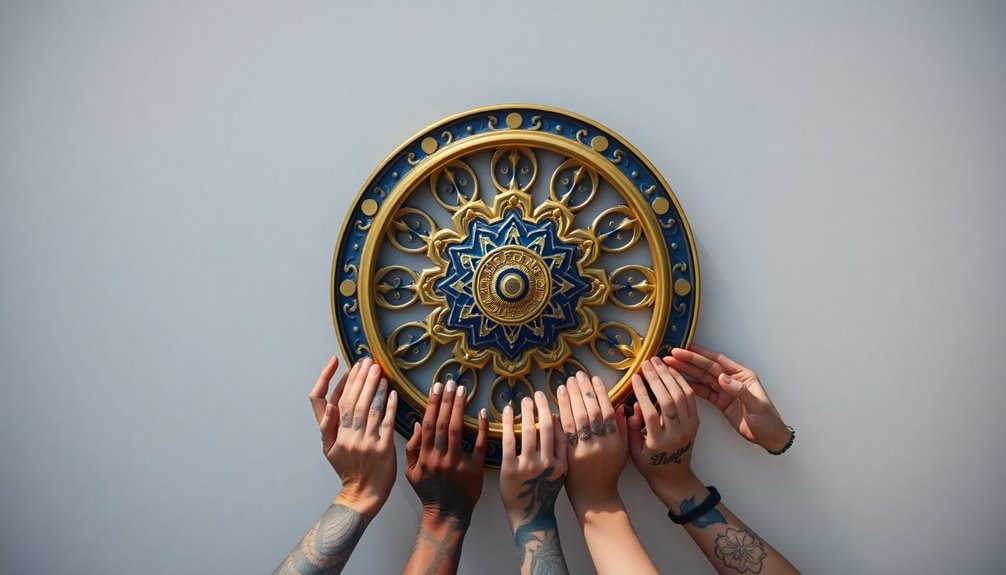
When you explore artistic representations of the Dharmachakra, you'll notice how traditional artworks have shaped its portrayal throughout history.
From ancient Indian monuments to the intricate designs in Gandharan Stele artworks, these pieces reflect the essence of Buddha's teachings.
Today, contemporary artists reinterpret the symbol, blending its historical significance with modern aesthetics.
Traditional Artwork Influence
Throughout history, traditional artwork has vividly captured the essence of the Dharma Wheel, or Dharmachakra, in various forms. This powerful symbol appears prominently in sculptures, murals, and paintings, especially within Buddhist temples.
You can see its influence through notable examples such as:
- Sanchi Stupa: Here, the Dharmachakra is intricately carved into pillars, reflecting Buddha's teachings and the spread of Buddhism during the Mauryan Empire.
- Gandharan Art: The Dharma Wheel is often illustrated alongside pivotal moments from Buddha's life, particularly his first sermon at Sarnath, which emphasizes its historical significance.
- Tibetan Thangka Paintings: These intricate artworks feature the Dharma Wheel as a central motif, symbolizing the cycle of life and the path to spiritual progress.
Each of these artistic representations showcases the Dharma Wheel as a key Buddhist symbol, enriching the viewer's understanding of its meaning.
From ancient times to today, traditional artwork continues to celebrate the profound teachings encapsulated in the Dharma Wheel, reminding you of the moral law and the journey toward enlightenment.
Contemporary Art Interpretations
Artists today are reimagining the Dharma Wheel, infusing it with fresh perspectives that resonate with contemporary issues. Contemporary artists often use the Dharma Wheel to explore themes like the spiritual journey and ethical living, merging traditional Buddhist imagery with modern artistic expression.
You might find the Dharmachakra featured prominently in urban art and street murals, symbolizing community resilience and the quest for enlightenment amidst diverse social contexts.
In the domain of modern digital art, the Dharma Wheel becomes a powerful motif, emphasizing its relevance in discussions about mindfulness and mental well-being in our fast-paced lives. Artists create installations that prompt reflection on the interconnectedness of life and the cyclical nature of existence, making these concepts accessible and relatable to you and other contemporary audiences.
Moreover, the incorporation of the Dharma Wheel in fashion and graphic design reflects a growing trend of blending spiritual symbols with everyday aesthetics. This trend not only beautifies your surroundings but also invites you to engage with Buddhist teachings in a more approachable way.
Through these artistic interpretations, the Dharma Wheel continues to inspire and challenge our understanding of life today.
Modern Cultural Uses
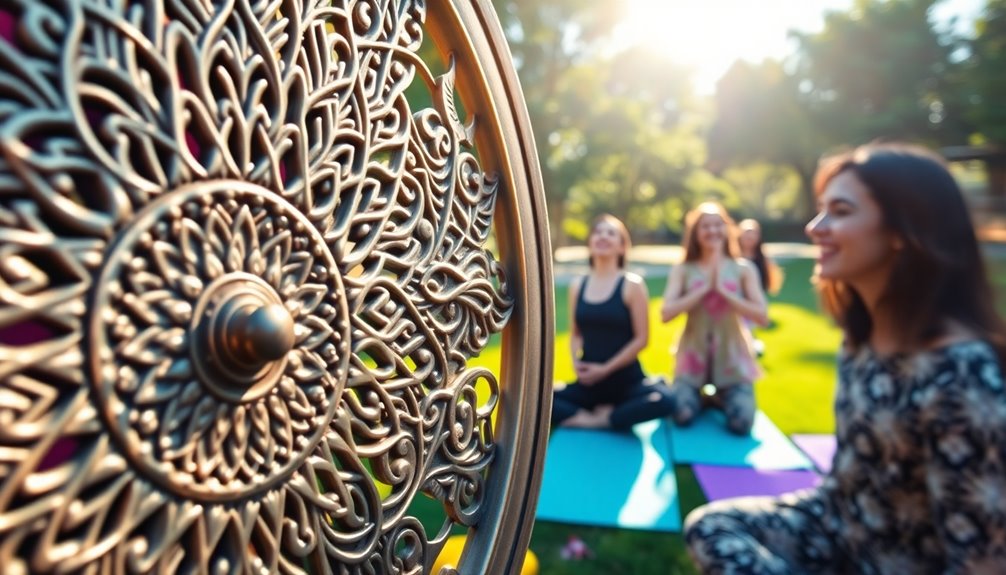
The Dharmachakra, or Dharma Wheel, plays an essential role in modern culture, appearing in various symbols and flags that reflect its deep significance. This ancient symbol not only represents Buddhist teachings but also embodies concepts of justice and social justice in contemporary society.
You can see the Dharma Wheel's influence in several areas:
- State Emblem of India: The Ashoka dharmachakra, with its 24 spokes, symbolizes the country's commitment to justice and moral order.
- Cultural Representation: In Thailand, the Dhammacakka flag showcases the importance of Buddhism in Thai culture, reinforcing national identity.
- Social Movements: The Dalit Buddhist Movement adopts the Dharmachakra to advocate for equality and social justice, highlighting its relevance in the fight against discrimination.
Additionally, modern organizations, including the U.S. Armed Forces' Buddhist chaplains, utilize the Dharma Wheel as an insignia, showcasing its spiritual significance in diverse contexts.
The Dharmachakra continues to resonate deeply, bridging ancient teachings with the contemporary quest for justice and equality.
Dharmachakra in Government Symbols

Government symbols often draw from cultural and historical significance, and the Dharmachakra stands out as a powerful emblem of righteousness and justice. In India, the State Emblem prominently features a 24-spoke Dharmachakra, symbolizing the eternal pursuit of truth and virtue in governance. The Ashoka Chakra, derived from the Dharmachakra, also appears in the national flag, emphasizing progress and the rule of law.
The use of the Dharmachakra extends beyond India's borders. Various governmental insignias worldwide incorporate it to signify moral authority and ethical governance, reflecting Buddhist values. Additionally, it plays an essential role in the Indian Dalit Buddhist Movement, where it represents social justice and equality in a modern political context.
| Symbol | Significance |
|---|---|
| Dharmachakra | Emblem of righteousness and justice |
| Ashoka Chakra | Symbol of progress and rule of law |
| State Emblem of India | Represents truth and virtue |
| Dalit Buddhist Movement | Advocates for social justice and equality |
| Global Insignias | Reflects moral authority and ethics |
These symbols remind us of the importance of justice and equality in governance.
Variations Across Religions

Across various religions, the Dharmachakra serves as a significant symbol, each interpretation reflecting unique philosophical and cultural values.
In Buddhism, it embodies the teachings of the Buddha, emphasizing the path to enlightenment.
In Jainism, the Dharmachakra symbolizes non-violence and spiritual purity, reinforcing their commitment to living harmoniously.
In Hinduism, the wheel signifies cosmic order, often associated with deities like Vishnu, who wields the Sudarśanacakra as a weapon against ignorance and evil.
Additionally, the Dharmachakra's presence in the State Emblem of India and its depiction on the national flag highlight the nation's dedication to justice and moral order.
Here are three key variations of the Dharmachakra across different cultures:
- Buddhism: Represents the path to enlightenment and the teachings of the Buddha.
- Jainism: Emphasizes non-violence and spiritual purity, reflecting their core beliefs.
- Hinduism: Symbolizes the cosmic order, connected to deities and the fight against ignorance.
These interpretations showcase how the Dharmachakra transcends cultures, embodying deep meanings in diverse spiritual contexts.
Scholarly Interpretations

Scholarly interpretations of the dharmachakra reveal a rich tapestry of meaning and significance within Buddhism and beyond. Scholars debate its historical importance as a symbol of Buddhist faith, noting how Buddha's disciples adopted the Dharma Wheel to represent his teachings and the spread of Buddhism.
The spoked design of the dharmachakra offers varying interpretations; some scholars argue that elongated symbols found in ancient inscriptions may not depict wheels but rather other forms of cosmic symbolism.
The origins of the dharmachakra also raise intriguing questions, especially given the absence of spoked wheel vehicles in the Harappan civilization. This absence suggests a potential evolution of the Wheel of Dharma within early Brahmanic thought.
Additionally, the cultural implications of wheel symbolism extend to the Sudarśanacakra associated with the Hindu god Vishnu, highlighting similarities and variations across ancient cultures.
In modern times, the dharmachakra's representation has been standardized in the Unicode system as U+2638, allowing for its digital use in communication and social media. This adaptability underscores the ongoing relevance of this Buddhist symbol in contemporary contexts.
Personal Reflections and Practices
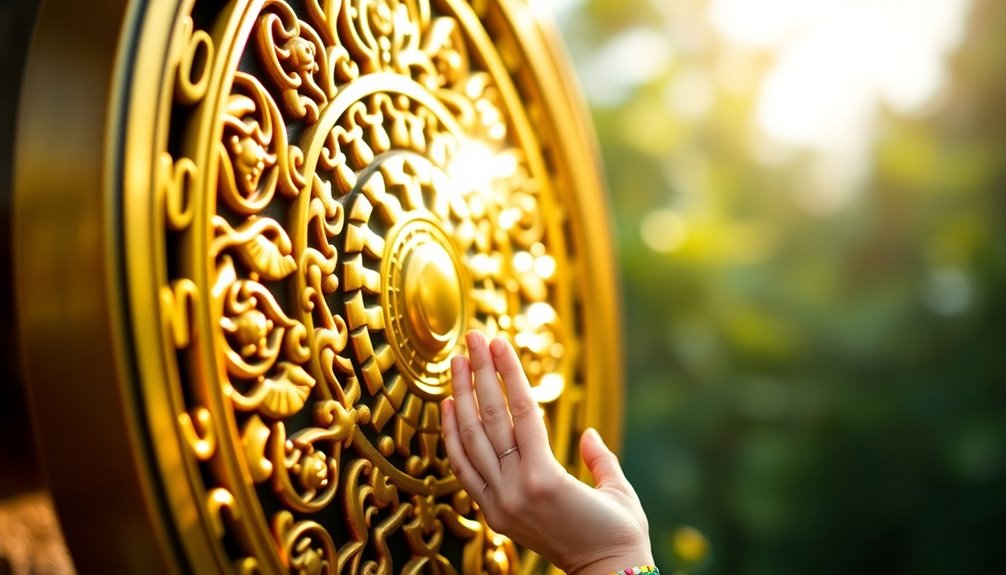
The Dharmachakra serves as a powerful symbol in personal spiritual practices, inviting individuals to explore its teachings on the Noble Eightfold Path. By meditating on this emblem, you can deepen your understanding of ethical living and personal growth, fostering a sense of empowerment in your daily life.
Here are three ways you can incorporate the Dharmachakra into your practices:
- Mindfulness Meditation: Focus on the wheel's symbolism during meditation sessions to cultivate awareness of your thoughts and actions. This can help you align with the principles of the Noble Eightfold Path.
- Daily Reflection: Take a moment each day to reflect on how you can embody the teachings of the Dharmachakra, evaluating your commitment to right action, right speech, and right livelihood.
- Community Engagement: Connect with others who share similar beliefs. By participating in groups or movements that emphasize empowerment and social justice, you can experience spiritual support while making a difference in the world.
Incorporating the Dharmachakra into your life can provide guidance as you navigate the complexities of modern existence, making ancient teachings relevant today.
Frequently Asked Questions
How Is the Dharma Wheel Used in Buddhism?
The Dharma Wheel is central to Buddhism, symbolizing Buddha's teachings and the path to enlightenment.
You'll see it during rituals and ceremonies, where it represents the turning of the wheel of Dharma. Its eight spokes illustrate the Noble Eightfold Path, guiding your ethical conduct and mental discipline.
In meditation, it serves as a visual aid, reminding you of interconnectedness and the importance of following Buddha's principles in your daily life.
What Is an Important Symbol in Buddhism That Represent the Dharma?
Like a guiding star in the night sky, the Dharma Wheel, or Dharmachakra, stands as an essential symbol in Buddhism. It embodies the teachings of the Buddha and the path to enlightenment.
With its hub, rim, and eight spokes, the wheel illustrates the Noble Eightfold Path, steering you toward ethical living and spiritual growth. Its circular form reflects the perfection of the Dharma and the cyclical journey of life, encompassing birth, death, and rebirth.
Why Is the Wheel of Life Important to Buddhism?
The Wheel of Life is essential to Buddhism because it visually represents the cycle of samsara—birth, death, and rebirth.
You'll see how it illustrates the interconnectedness of all life forms and highlights the importance of understanding suffering.
By depicting the six domains of existence, it reminds you of the consequences of karma.
What Does the ☸ Symbol Mean?
The ☸ symbol, known as the Dharmachakra, represents the teachings of Buddhism and the path to enlightenment.
When you see it, think of the Eightfold Path, which guides you in ethical living and spiritual practice. The eight spokes symbolize essential steps like right view and right action, while the wheel's circular shape reflects life's cyclical nature, including birth and rebirth.
Conclusion
In today's world, the Dharma Wheel serves as a reminder of balance and purpose, much like a compass guiding lost travelers. Imagine a hiker steering through a dense forest; each turn represents a step on the Noble Eightfold Path, leading to clarity and peace. Just as that hiker finds their way home, you can apply the principles of the Dharma Wheel in your own life, fostering mindfulness and harmony in an often chaotic world.

